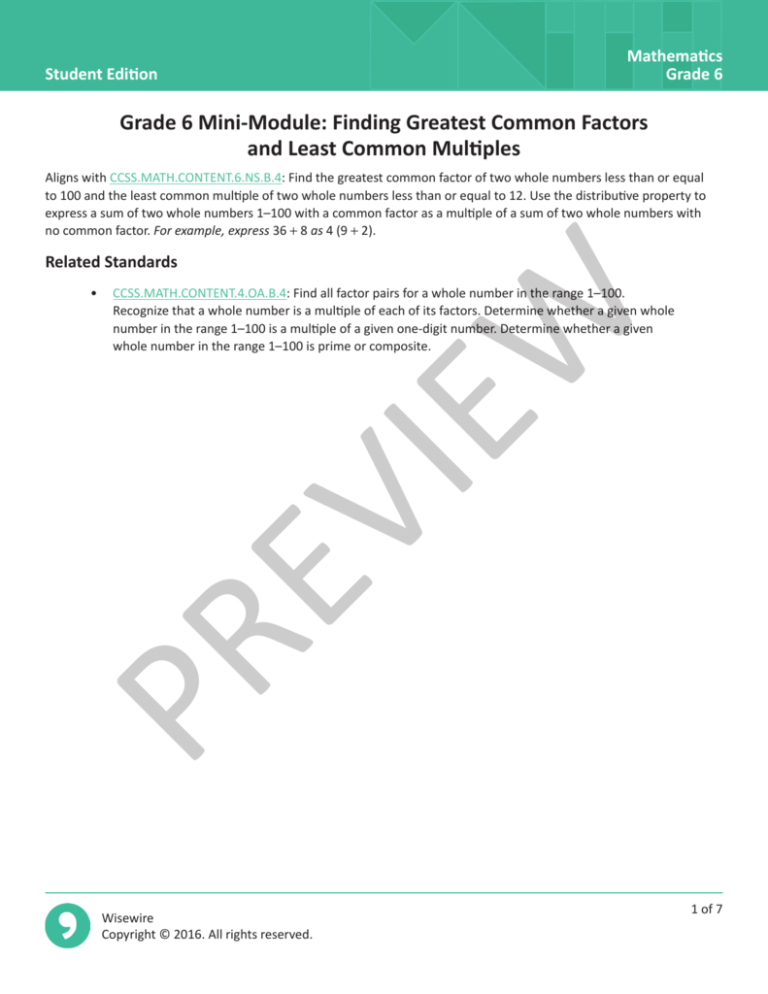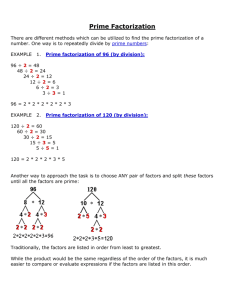
Mathematics
Grade 6
Student Edition
Grade 6 Mini-Module: Finding Greatest Common Factors
and Least Common Multiples
Aligns with CCSS.MATH.CONTENT.6.NS.B.4: Find the greatest common factor of two whole numbers less than or equal
to 100 and the least common multiple of two whole numbers less than or equal to 12. Use the distributive property to
express a sum of two whole numbers 1–100 with a common factor as a multiple of a sum of two whole numbers with
no common factor. For example, express 36 + 8 as 4 (9 + 2).
Related Standards
PR
E
VI
EW
• CCSS.MATH.CONTENT.4.OA.B.4: Find all factor pairs for a whole number in the range 1–100.
Recognize that a whole number is a multiple of each of its factors. Determine whether a given whole
number in the range 1–100 is a multiple of a given one-digit number. Determine whether a given
whole number in the range 1–100 is prime or composite.
Wisewire
Copyright © 2016. All rights reserved.
1 of 7
Mathematics
Grade 6
Student Edition
Objectives
In this module, you will learn and practice the following skills:
• Find the greatest common factor of two whole numbers less than 100.
• Find the least common multiple of two whole numbers less than 100.
Let’s get started!
Key Terms
EW
• Use the distributive property to express the sum of two numbers with a common factor as the product of the common factor and the sum of two numbers that do not have a common factor.
• A factor is a number that divides evenly into another number.
• The greatest common factor of two whole numbers is the greatest whole number that divides
evenly into both numbers.
• A prime factor is a prime number that is a factor of a number.
VI
• The prime factorization of a number a multiplication expression whose factors are only prime
numbers whose product is the number.
• Relatively prime numbers have no common factors other than 1.
PR
E
• The distributive property is a property of numbers that states that the product of a factor and a sum
can be written as a sum of two products.
• A multiple is a number that can be evenly divided by another number.
• The least common multiple of two whole numbers is the least whole number that is evenly divisible
by both numbers.
Wisewire
Copyright © 2016. All rights reserved.
2 of 7
Mathematics
Grade 6
Teacher Edition
Finding Greatest Common Factors and Least Common Multiples
(CCSS.Math.Content.6.NS.B.4)
The greatest common factor (GCF) of two numbers is the greatest whole number that divides evenly into both numbers.
To find the GCF of two numbers:
• List the factors of each number and identify the greatest common factor; or
EW
• List the prime factorization of each number and identify the prime factors that are included in both
prime factorizations, then find the product of the prime factors.
What is the greatest common factor of 18 and 24?
Method 1
Factors of 18: 1, 2, 3, 6 , 9, 18
Factors of 24: 1, 2, 3, 4, 6 , 8, 12, 24
The greatest common factor is 6.
Method 2
Prime factorization of 18: 2 × 3 × 3
Prime factorization of 24: 2 × 2 × 2 × 3
Common prime factors: 2 × 3
The greatest common factor is 2 × 3 = 6.
VI
If the greatest common factor of two numbers is 1, the numbers are relatively prime.
9 and 20 are relatively prime:
• The factors of 9 are 1, 3, and 9
PR
E
• The factors of 20 are 1, 2, 4, 5, 10, and 20
• The greatest common factor is 1
Use the distributive property to rewrite a sum of two whole numbers with a common factor as a multiple of a sum of
two whole numbers with no common factor.
Rewrite 28 + 32 as a multiple of a sum of two whole numbers.
• The prime factorization of 28 is 2 × 2 × 7.
• The prime factorization of 32 is 2 × 2 × 2 × 2 × 2.
• The common prime factors are 2 × 2.
• The greatest common factor is 4.
28 + 32 = 4(7 + 8)
Wisewire
Copyright © 2016. All rights reserved.
1 of 3








